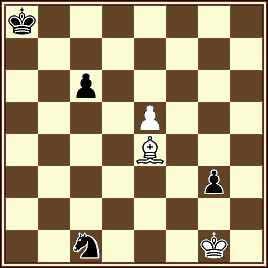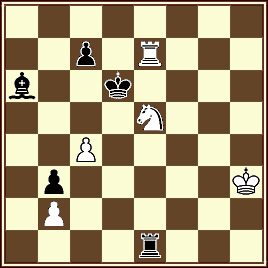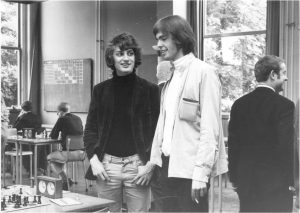Finales
Columnista Invitado
Harold van der Heijden
Harold,es un compositor holandés de ajedrez estudios de finales . Nació en Veghel , Países Bajos en 1960. Es Dr. Veterinario y se desempeña como jefe del departamento de Investigación y Desarrollo de un instituto de su especialidad.
Su colección de estudios de fase final es probablemente la más grande en el mundo (contando más de 73.000 estudios a partir de julio de 2008). Esta colección es de gran ayuda para los jueces en la comprobación de la anticipación. Él fue consultado por los jueces de torneos y también organizó y actuo como juez en varios torneos de finales de estudio . En 2001 le fue concedido por la Comisión Permanente de la FIDE para Composiciones de Ajedrez (PCCC) el título de Juez Internacional de Composición de Ajedrez para los estudios finales.
Ha publicado más de 100 de sus propios estudios. Participando en torneos, obtuvo premios, distinciones y elogios . Fue nombrado por la Comisión Permanente de la FIDE para Composiciones de Ajedrez (PCCC), como Director de la Sección del álbum de la FIDE para el estudio de la sección final del juego a partir del Album 1998-2000.
Fue editor (1989) y más tarde editor jefe (1993) de la revista de los EBUR d’Arves círculo holandeses de finales. EBUR se fusionó en 2007 con la famosa revista internacional de fase final de estudio EG fundada por John Roycroft en 1965. También fue editor de esta revista desde 1991 y actualmente es el editor jefe de la mencionada revista de reconocido prestigio a nivel internacional..
A selection of Dutch endgame studies
By Harold van der Heijden
Jan Marwitz
1st prize Tijdschrift van de KNSB 1937–WIN
 The win must come from the e5-pawn. But the obvious 1.e6? fails to 1…Se2+ 2.Kf1 g2+! 3.Bxg2 (Kxg2 Sf4+;) 3…Sg3+ 4.Kf2 Sf5 (Sh5). Only the spectacular 1.Bd3! wins: 1…Kb7 (Sxd3; e6) 2.Bc4 Kb6 3.Kg2 Kc5 4.Kxg3! Kxc4 5.e6 Se2+ and now almost every K-move fails. Of course 6.Kg2?, 6.Kf3? and 6.Kh3? fail to a direct fork, while 6.Kh4? Sd4 (Sf4) 7.e7 the bS also forks. Only 6.Kh2! wins.
The win must come from the e5-pawn. But the obvious 1.e6? fails to 1…Se2+ 2.Kf1 g2+! 3.Bxg2 (Kxg2 Sf4+;) 3…Sg3+ 4.Kf2 Sf5 (Sh5). Only the spectacular 1.Bd3! wins: 1…Kb7 (Sxd3; e6) 2.Bc4 Kb6 3.Kg2 Kc5 4.Kxg3! Kxc4 5.e6 Se2+ and now almost every K-move fails. Of course 6.Kg2?, 6.Kf3? and 6.Kh3? fail to a direct fork, while 6.Kh4? Sd4 (Sf4) 7.e7 the bS also forks. Only 6.Kh2! wins.
Beautiful miniature with multiple sacrifices from Jan H. Marwitz (1915-1991), the best Dutch endgame study composer of all times.
J. Selman
1st prize Tijdschrift van de KNSB 1949 – WIN
 1.Sf5! clears the a1-h8 diagonal and threatens 2.f7+. 1…Re1+ Now White is unable to protect his bishop as 2.Kb2 closes the long diagonal again. But: 2.Kd2 Rxa1 3.f7 and now after 3…Ra2+ White must be very careful. E.g. 4.Kd3? Bxf5+ and 5…Kg7. 4.Kc1? Ra1+ 4.Kb2 Rb1+ 6.Kxb1 Bf5+; 4.Ke3? Ra3+ 5.Ke2 (5.Kd4 Rd3+! or 5.Kf2 Rf3+!) 5…Ba6+ 6.Ke1 Re3+ 7.Sxe3 Kg7 draws; 4.Kc3? Rc2+ 5.Kb4 Rb2+! 6.Ka3 Ra2+ 7.Kxa2 Be6+ draws. Only 4.Ke1! works. 4…Ra1+ 5.Kf2! g3+ Now 6.Kxg3? fails to 6…Rg1+ 7.Kf2 Rg8, so 6.Ke3! Ra3+ 7.Kf4 (Kd4? Rd3+!) 7…Ra4+ 8.Kg5 Rg4+ 9.Kh6! Rg8 (9…Rg6+ 10.Kxg6 Bxf5+ 11.Kf(h)6) 10.Se7 Be6 11.fxg8Q(R)+ Bxg8 12.Sg6 mate.
1.Sf5! clears the a1-h8 diagonal and threatens 2.f7+. 1…Re1+ Now White is unable to protect his bishop as 2.Kb2 closes the long diagonal again. But: 2.Kd2 Rxa1 3.f7 and now after 3…Ra2+ White must be very careful. E.g. 4.Kd3? Bxf5+ and 5…Kg7. 4.Kc1? Ra1+ 4.Kb2 Rb1+ 6.Kxb1 Bf5+; 4.Ke3? Ra3+ 5.Ke2 (5.Kd4 Rd3+! or 5.Kf2 Rf3+!) 5…Ba6+ 6.Ke1 Re3+ 7.Sxe3 Kg7 draws; 4.Kc3? Rc2+ 5.Kb4 Rb2+! 6.Ka3 Ra2+ 7.Kxa2 Be6+ draws. Only 4.Ke1! works. 4…Ra1+ 5.Kf2! g3+ Now 6.Kxg3? fails to 6…Rg1+ 7.Kf2 Rg8, so 6.Ke3! Ra3+ 7.Kf4 (Kd4? Rd3+!) 7…Ra4+ 8.Kg5 Rg4+ 9.Kh6! Rg8 (9…Rg6+ 10.Kxg6 Bxf5+ 11.Kf(h)6) 10.Se7 Be6 11.fxg8Q(R)+ Bxg8 12.Sg6 mate.
John Selman (1904-1978) was famous for his in-depth investigations and e.g. unravelled the story of the Saavedra-study. Perhaps his above study is one of the best Dutch endgame studies ever. It anticipated a famous 1951-study by GM Vladimir Korolkov (HHdbIV#24982). Of course it is understandable that Korolkov didn’t know about Selman’s study, but for some reason the Russians for a long time argued about the relevance of Selman’s masterpiece. But in his posthumous book “I choose the idea” (1998) Korolkov simply writes “as is turned out, this study has a predecessor”, quoting Selman’s study.
J. van Reek
Commendation Shakhmaty v SSSR 1969 –WIN
 Harrie Grondijs pointed out that the initial position of this study pictures the double DNA helix. 1.dxe3 fxe6 2.exd4 exf5 3.dxe5 fxe4 4.exd6 exf3 5.dxe7 fxe2 6.e8Q wins.
Harrie Grondijs pointed out that the initial position of this study pictures the double DNA helix. 1.dxe3 fxe6 2.exd4 exf5 3.dxe5 fxe4 4.exd6 exf3 5.dxe7 fxe2 6.e8Q wins.
Jan van Reek (1945) is by far the most prolific Dutch writer on endgame studies. He also invented a new genre: “ultra-modern endgame studies”, i.e. studies with several phases.
+-
H. Weenink
6th prize Kagan’s Neueste Schachnachrichten 1920 – WIN
 With a piece up this at first sight looks like an easy win. But it is not easy at all! For instance 1.Bb3? fails to 1…Kc3 2.Kb5 (2.g6 Kd4 3.Kb4 Ke5) 2…Kd4! 3.Kc6 Ke5 4.g6 Kf6 5.Bf7 Ke7 and the bK reaches f8 and draws. Also seizing the opposition by 1.Kb4? fails to 1… Kxc2 2.Kc4 Kd2 3.Kd4 Ke2 4.Ke4 Kf2 5.Kf4 Kg2 6.Kg4 g6 and Black got the opposition after all. Not so easy to refute is 1.Bd1? since 1…Kc1 (which the composer intended) fails to 2.Bh5 (Bb3) Kd2 3.Bf7! Ke3 4.g6 Kd4 5.Kb5 Ke5 6.Kc6 Kf6 7.Kd7. But, luckily, 1…Kc3 2.Kb5 Kd4 3.Kc6 Ke5 4.Bc2 and now not the composer’s 4…Kf4 5.g6 Ke5 6.Kd7 Kf6 7.Ke8 wins, but 4…g6! 5.Bxg6 Kf4 draws.
With a piece up this at first sight looks like an easy win. But it is not easy at all! For instance 1.Bb3? fails to 1…Kc3 2.Kb5 (2.g6 Kd4 3.Kb4 Ke5) 2…Kd4! 3.Kc6 Ke5 4.g6 Kf6 5.Bf7 Ke7 and the bK reaches f8 and draws. Also seizing the opposition by 1.Kb4? fails to 1… Kxc2 2.Kc4 Kd2 3.Kd4 Ke2 4.Ke4 Kf2 5.Kf4 Kg2 6.Kg4 g6 and Black got the opposition after all. Not so easy to refute is 1.Bd1? since 1…Kc1 (which the composer intended) fails to 2.Bh5 (Bb3) Kd2 3.Bf7! Ke3 4.g6 Kd4 5.Kb5 Ke5 6.Kc6 Kf6 7.Kd7. But, luckily, 1…Kc3 2.Kb5 Kd4 3.Kc6 Ke5 4.Bc2 and now not the composer’s 4…Kf4 5.g6 Ke5 6.Kd7 Kf6 7.Ke8 wins, but 4…g6! 5.Bxg6 Kf4 draws.
The amazing key move is 1.Bb1! Kxb1 (1…Kc3 2.Kb5 Kd4 3.Kc6 Ke5 4.Kd7 g6 5.Ke7 Kf4 6.Kf6 wins) 2.Kb3 Kc1 3.Kc3 Kd1 4.Kd3 Ke1 5.Ke3 Kf1 6.Kf3 and wins, e.g. 6…Kg1 7.Kg3 g6 8.Kf4.
Henri Weenink (1892-1931) was a very talented Dutch problemist who died at an early age. Perhaps his Bb1-study features the most surprising key move of all Dutch endgame studies.
The Art of the Endgame 2011 –WIN
Composed 2010, dedicated to Harry Mulisch
 White will lose a piece: 1.Rd7+ Ke6 2.Rxc7 since Black has 2…Re3+. If now 3.K- Black can play 3…Kxe5 and the bK is able to defend its rook after 4.Re7+. However: 3.Sf3! Rxf3+ 4.Kg2, threatening both to capture the bR and to check on c6. 4…Rc3! 5.bxc3 After 5.Rc6+ Ke5! 6.Rxa6 Rc2+ 7.Kf3 Kd4! Black wins the rook ending. 5…Bb5! A spectacular move blocking the b-file. Now it seems impossible for White to prevent promotion of the b-pawn. However: 6.Rc5 and the bB is in problems (6…Be8(Ba4) 7.Rc8 and White even wins), 6…Bd7 and now only the illogical looking move 7.Rg5! stops the b-pawn. 7.Rh5? Bc6+ 8.K- b2 as h1 is covered. If now 7…Bc6+ e.g. 8.Kf2 b2 9.Rg1. 7…b2 8.Rg6+ and 9.Rb6 even wins.
White will lose a piece: 1.Rd7+ Ke6 2.Rxc7 since Black has 2…Re3+. If now 3.K- Black can play 3…Kxe5 and the bK is able to defend its rook after 4.Re7+. However: 3.Sf3! Rxf3+ 4.Kg2, threatening both to capture the bR and to check on c6. 4…Rc3! 5.bxc3 After 5.Rc6+ Ke5! 6.Rxa6 Rc2+ 7.Kf3 Kd4! Black wins the rook ending. 5…Bb5! A spectacular move blocking the b-file. Now it seems impossible for White to prevent promotion of the b-pawn. However: 6.Rc5 and the bB is in problems (6…Be8(Ba4) 7.Rc8 and White even wins), 6…Bd7 and now only the illogical looking move 7.Rg5! stops the b-pawn. 7.Rh5? Bc6+ 8.K- b2 as h1 is covered. If now 7…Bc6+ e.g. 8.Kf2 b2 9.Rg1. 7…b2 8.Rg6+ and 9.Rb6 even wins.
GM Jan Timman has always had a passion for endgame studies. His most recent book, from which I quote the excellent study, is his first book fully dealing with endgame studies. Highly appreciated!
http://www.newinchess.com/The_Art_of_the_Endgame-p-957.html
The study above was dedicated to Harry Mulisch (1927-2010), who is considered to be one of the best Dutch post-war writers (and regularly thought of as a possible Nobel laureate). In 2007 his 1992 novel The Discovery of Heaven was elected as the best Dutch novel of all times.
Harold van der Heijden
Algemeen Dagblad 18i2003 – WIN
 This position I discovered while I was working on an article on pawn breakthroughs in my magazine EBUR. It appeals to both beginners as well as very strong players as it can be solved by everybody by the trial-and-error method, while it is still fun (i.e. difficult) for the more gifted o.t.b. players. Surely, everybody appreciates that White’s win should come from a pawn breakthrough combination. However, 1.g5? fxg5 and Black even wins as the black g-pawn advances with check. And 1.e5? fxe5 2.g5 e4 3.g6 e3 4.g7 e2 5.g8Q e1Q is a draw. Perhaps 1.Kh3? In that case, after 1…Kf3! White has nothing better than 2.e5 fxe5 3.g5 e4 4.g6 e3 5.g7 e2 6.g8Q e1Q with a draw we recognize from the 1.e5? line. The only legal move that remains is the surprising 1.Kh1!, which is “of course” the solution. Obviously, if Black plays to the e-file (1…Ke3) then White plays 2.e5 fxe5 3.g5 e4 4.g6 and the black king obstructs his e-pawn, while playing to the g-file (1…Kg3) allows White to promote with check: 2.e5 fxe5 3.g5 e4 4.g6 e3 5.g7 e2 6.g8Q+ and win. More difficult is 1…Kf3. White then plays 2.e5! (not 2.g5? fxg5 3.e5? – still attempting to win – 3…Kf2 and White is mated) 2…fxe5 3.g5 e4 and now 4.Kg1! e3 5.Kf1 and wins. But, almost everybody asked, what about? 1…Kf1, that seems to change nothing to the initial position. But it does: 2.e5! fxe5 3.g5 e4 4.g6 e3 5.g7 e2 6.g8Q e1Q with a position that we have seen with the kings shifted one or two files up. Here’s the difference: 7.Qg2 mate!
This position I discovered while I was working on an article on pawn breakthroughs in my magazine EBUR. It appeals to both beginners as well as very strong players as it can be solved by everybody by the trial-and-error method, while it is still fun (i.e. difficult) for the more gifted o.t.b. players. Surely, everybody appreciates that White’s win should come from a pawn breakthrough combination. However, 1.g5? fxg5 and Black even wins as the black g-pawn advances with check. And 1.e5? fxe5 2.g5 e4 3.g6 e3 4.g7 e2 5.g8Q e1Q is a draw. Perhaps 1.Kh3? In that case, after 1…Kf3! White has nothing better than 2.e5 fxe5 3.g5 e4 4.g6 e3 5.g7 e2 6.g8Q e1Q with a draw we recognize from the 1.e5? line. The only legal move that remains is the surprising 1.Kh1!, which is “of course” the solution. Obviously, if Black plays to the e-file (1…Ke3) then White plays 2.e5 fxe5 3.g5 e4 4.g6 and the black king obstructs his e-pawn, while playing to the g-file (1…Kg3) allows White to promote with check: 2.e5 fxe5 3.g5 e4 4.g6 e3 5.g7 e2 6.g8Q+ and win. More difficult is 1…Kf3. White then plays 2.e5! (not 2.g5? fxg5 3.e5? – still attempting to win – 3…Kf2 and White is mated) 2…fxe5 3.g5 e4 and now 4.Kg1! e3 5.Kf1 and wins. But, almost everybody asked, what about? 1…Kf1, that seems to change nothing to the initial position. But it does: 2.e5! fxe5 3.g5 e4 4.g6 e3 5.g7 e2 6.g8Q e1Q with a position that we have seen with the kings shifted one or two files up. Here’s the difference: 7.Qg2 mate!
———————————————————————————————————-
DOS GRANDES AMIGOS
Estudio comentado por el GM Pablo Ricardi – PDF – PDF
Artículo del Dr. Jesús Seoane Sepúlveda (España):– Jan Timman Estudios en Ajedrez con Maestros PGN
==========================================================
PETER BOLL with NADIA CIPRIANI (girlfriend of P. KRUG) and FRAU VON P. BOLL – (AUSTRIA-2019)
====================================================
Otros estudios de compositores de Holanda
Seleccionados por Mario G. García
T.Kok – 1939 Nº1 2.p Schackvärlden Tablas Tablas |
De Feijter – 1936 Nº2 Deventer Dagblad  Ganan Ganan |
J.Van den Ende – 1968 Nº3 1.p Schakend Neder. Tablas Tablas |
J.Marwitz – 1984 Nº4 1.p Rueb MT Ganan Ganan |
J.Timman-J.Van Reek–1994 Nº5 1.p Wola Gulowska Ganan Ganan |
W. Mees – 1954 Nº6 1.p Tijdsch.vd. KNSB Ganan Ganan |
H.Grondijs – 1993 Nº7 1.p Boris JT (c) Ganan Ganan |
H.Van der Heijden–2001 Nº8 1.p Uralski  Tablas Tablas |
J.Selman –1966 Nº9 3.p New Statesman Ganan Ganan |
| Soluciones: Clickear en el diagrama | Todas las Soluciones | |
| VOLVER: Compositores de Otros Países | ||
Seleccion de Estudios en ARVES: Jan Timman – Jan Marwitz – Harold van der Heijden – Jan van Reek – Johan J. van den Ende – Henri Weenink – Gijs van Breukelen – Anton Balemans – Nico Cortlever – Cor de Feijter – Willem Korteling – Theo Kok – Martin van Essen – Arthur Joseph Wijnans – Harrie Grondijs _
SITIOS SUGERIDOS
2.-Harold Van der Heijden (HHdbIV)





